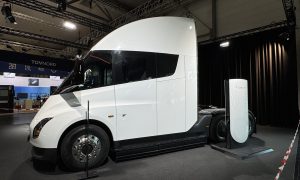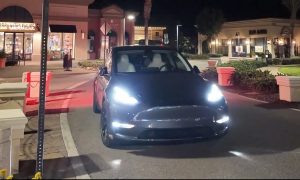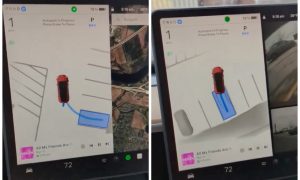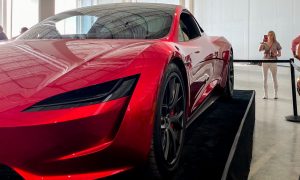News
What does a Tesla Model S owner think of the Chevy Bolt? (Full review)
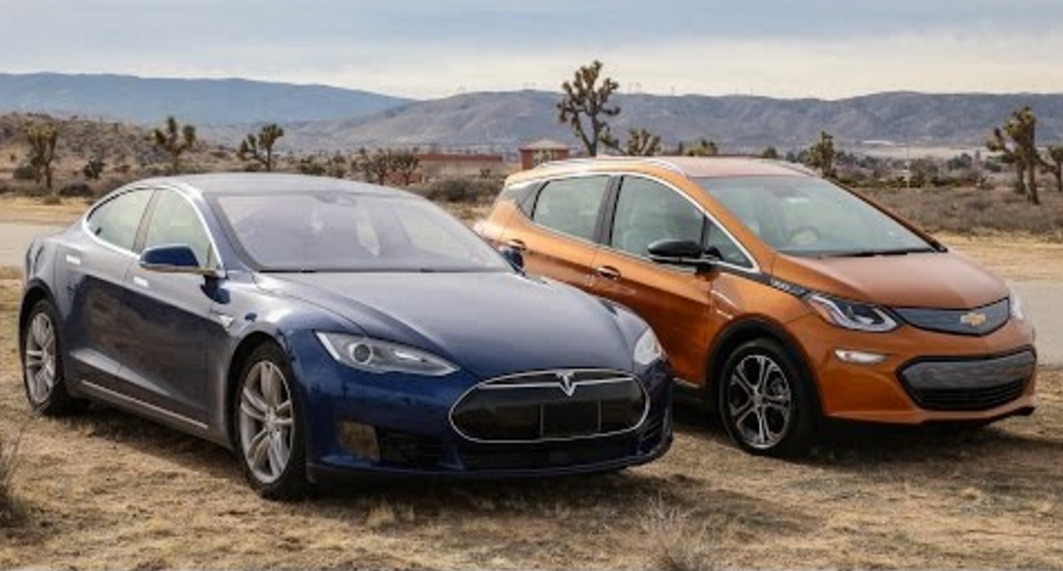
Southern California Tesla Model S owner Alex Venz was recently given 24-hour access to a Chevy Bolt with the stipulation that he not drive it more than 100 miles. After his time with the car was up, Alex put together a lengthy video that explores the Bolt and highlights some of its pluses and minuses.
For starters, Alex found the Bolt was somewhat smaller than the Nissan LEAF he used to own. He calls it larger than a Ford Fiesta but smaller than a Ford Focus. His first impression is that the seats are somewhat narrow. In fact, they measure about 17 inches wide. A quick check on his Model S finds those seats are about 20 inches wide, as are the seats in a Honda Accord he had access to. So the Bolt is a little tight when it comes to hip room.
Head room is another story. The Bolt has more front and rear head room than the Model S. Venz, who says he is 5′ 9″ finds he has almost no headroom in the back seat of his Model S but about 3 inches of clearance in the Bolt. Front headroom in the Bolt is about double what he has in his Model S.
Luggage capacity is also significantly greater in the Tesla. The Bolt can handle three moderate size carry on bags, but with little to no room left over. The rear seats of the Bolt do fold flat, however. Lenz says there’s not enough room to actually lie down in back with the seats folded, but there is enough room for lots of cargo if the rear seats aren’t needed for passengers.
The Bolt takes about 2 seconds more to get to 60 mph than Lenz’s Model S 70 but the time required is still around 7 seconds, which is fairly quick in comparison to most in-category cars with internal combustion engines. The quality of interior materials is adequate, Lenz finds, and he notes that the Bolt has fewer squeaks and rattles than his Model S.
Checking out the car’s controls, Venz found the Bolt comes up short when it comes to ease of operation. The touchscreen is customizable, but requires far more effort to drill down through the available menus than the Tesla does. The Bolt also has no built in navigation function for route planning or finding charging locations. Instead, Bolt drivers will have to rely on apps or the mapping functions provided by Apple Car Play or Android Auto. Neither map program is as fully featured as what Tesla offers.
Venz notes that CCS quick charging is a $750 option. Without it, the Bolt can only be charged at either 8 or 12 amps from a household outlet, or roughly 3 miles of range per hour of charge. Just as with the Chevy Volt, 8 amps is the default setting. The driver must manually select the 12 amp setting every time, which is tedious. The car also is programmed to do a 100% charge every time. There is no way to select a lesser charging level.
Update: In the comments to this post, several people took issue with Venz’s information on charging. This comes from GreenMonkeyPants: “Untrue. without the CSS option, there’s a standard J1772 that will charge at 32A @240V.” Further information may be obtained from the website Chevy EV Life.
The ride and handling of the Bolt are described as good. The car is responsive and nimble in a way the Model S, being considerably larger, is not. Venz does praise the regenerative braking feature built into the Bolt, which he says permits one pedal driving. The regen is available even with a full battery and can be boosted with a paddle mounted low and on the left side of the steering wheel.
Venz’s conclusion is that the Bolt is an excellent car for someone who will use it primarily for commuting. It has more than adequate range for most people, it is comfortable, and fun to drive. The seating position is higher than in the Model S and is more like what a driver would expect in a crossover SUV than a sedan. That’s a big plus for a lot of drivers.
On balance, Venz feels the Bolt is one of the best products to come from Chevrolet in quite some time. Comparing prices and functions with the Model S, the Bolt is a good car for the money and may actually be better suited to the way ordinary people drive on a daily basis than the Model S.
That’s not the whole story, of course. The real test will be how the Chevy Bolt stacks up against the Model 3. Most people expect the Tesla midsize car to be more refined and offer a higher level of technology than the Bolt. The Chevrolet product has lane keeping assist, blind spot warnings, and automatic emergency braking available but nothing similar to the Autosteer or TACC features available in the Tesla. The Model 3 will be capable of full autonomous driving; the Bolt is not. It will be interesting to see how the two cars compare when both are available to consumers.
Elon Musk
Tesla investors will be shocked by Jim Cramer’s latest assessment
Jim Cramer is now speaking positively about Tesla, especially in terms of its Robotaxi performance and its perception as a company.

Tesla investors will be shocked by analyst Jim Cramer’s latest assessment of the company.
When it comes to Tesla analysts, many of them are consistent. The bulls usually stay the bulls, and the bears usually stay the bears. The notable analysts on each side are Dan Ives and Adam Jonas for the bulls, and Gordon Johnson for the bears.
Jim Cramer is one analyst who does not necessarily fit this mold. Cramer, who hosts CNBC’s Mad Money, has switched his opinion on Tesla stock (NASDAQ: TSLA) many times.
He has been bullish, like he was when he said the stock was a “sleeping giant” two years ago, and he has been bearish, like he was when he said there was “nothing magnificent” about the company just a few months ago.
Now, he is back to being a bull.
Cramer’s comments were related to two key points: how NVIDIA CEO Jensen Huang describes Tesla after working closely with the Company through their transactions, and how it is not a car company, as well as the recent launch of the Robotaxi fleet.
Jensen Huang’s Tesla Narrative
Cramer says that the narrative on quarterly and annual deliveries is overblown, and those who continue to worry about Tesla’s performance on that metric are misled.
“It’s not a car company,” he said.
He went on to say that people like Huang speak highly of Tesla, and that should be enough to deter any true skepticism:
“I believe what Musk says cause Musk is working with Jensen and Jensen’s telling me what’s happening on the other side is pretty amazing.”
Tesla self-driving development gets huge compliment from NVIDIA CEO
Robotaxi Launch
Many media outlets are being extremely negative regarding the early rollout of Tesla’s Robotaxi platform in Austin, Texas.
There have been a handful of small issues, but nothing significant. Cramer says that humans make mistakes in vehicles too, yet, when Tesla’s test phase of the Robotaxi does it, it’s front page news and needs to be magnified.
He said:
“Look, I mean, drivers make mistakes all the time. Why should we hold Tesla to a standard where there can be no mistakes?”
It’s refreshing to hear Cramer speak logically about the Robotaxi fleet, as Tesla has taken every measure to ensure there are no mishaps. There are safety monitors in the passenger seat, and the area of travel is limited, confined to a small number of people.
Tesla is still improving and hopes to remove teleoperators and safety monitors slowly, as CEO Elon Musk said more freedom could be granted within one or two months.
News
Tesla launches ultra-fast V4 Superchargers in China for the first time
Tesla has V4 Superchargers rolling out in China for the first time.

Tesla already has nearly 12,000 Supercharger piles across mainland China. However, the company just initiated the rollout of the ultra-fast V4 Superchargers in China for the first time, bringing its quick-charging piles to the country for the first time since their launch last year.
The first batch of V4 Superchargers is now officially up and running in China, the company announced in a post on Chinese social media outlet Weibo today.
The company said in the post:
“The first batch of Tesla V4 Superchargers are online. Covering more service areas, high-speed charging is more convenient, and six-layer powerful protection such as rain and waterproof makes charging very safe. Simultaneously open to non-Tesla vehicles, and other brands of vehicles can also be charged. There are more than 70,000 Tesla Superchargers worldwide. The charging network layout covers 100% of the provincial capitals and municipalities in mainland China. More V4 Superchargers will be put into use across the country. Optimize the charging experience and improve energy replenishment efficiency. Tesla will accompany you to the mountains, rivers, lakes, and seas with pure electricity!”
The first V4 Superchargers Tesla installed in China are available in four cities across the country: Shanghai, Zhejiang, Gansu, and Chongqing.

Credit: Tesla China
Tesla has over 70,000 Superchargers worldwide. It is the most expansive and robust EV charging network in the world. It’s the main reason why so many companies have chosen to adopt Tesla’s charging connector in North America and Europe.
In China, some EVs can use Tesla Superchargers as well.
The V4 Supercharger is capable of charging vehicles at speeds of up to 325kW for vehicles in North America. This equates to over 1,000 miles per hour of charging.
Elon Musk
Elon Musk hints at when Tesla could reduce Safety Monitors from Robotaxi
Tesla could be reducing Safety Monitors from Robotaxi within ‘a month or two,’ CEO Elon Musk says.

Elon Musk hinted at when Tesla could begin reducing Safety Monitors from its Robotaxis. Safety Monitors are Tesla employees who sit in the front passenger seat during the driverless rides, and are there to ensure safety for occupants during the earliest rides.
Tesla launched its Robotaxi fleet in Austin last Sunday, and after eight days, videos and reviews from those who have ridden in the driverless vehicles have shown that the suite is safe, accurate, and well coordinated. However, there have been a few hiccups, but nothing that has put anyone’s safety in danger.
A vast majority — close to all of the rides — at least according to those who have ridden in the Robotaxi, have been performed without any real need for human intervention. We reported on what was the first intervention last week, as a Safety Monitor had to step in and stop the vehicle in a strange interaction with a UPS truck.
Watch the first true Tesla Robotaxi intervention by safety monitor
The Tesla and UPS delivery truck were going for the same street parking space, and the Tesla began to turn into it. The UPS driver parallel parked into the spot, which was much smaller than his truck. It seemed to be more of an instance of human error instead of the Robotaxi making the wrong move. This is something that the driverless cars will have to deal with because humans are aggressive and sometimes make moves they should not.
The Safety Monitors have not been too active in the vehicles. After all, we’ve only seen that single instance of an intervention. There was also an issue with the sun, when the Tesla braked abnormally due to the glare, but this was an instance where the car handled the scenario and proceeded normally.
With the Robotaxi fleet operating impressively, some are wondering when Tesla will begin scaling back both the Safety Monitors and Teleoperators that it is using to ensure safety with these early rides.
CEO Elon Musk answered the inquiry by stating, “As soon as we feel it is safe to do so. Probably within a month or two.”
As soon as we feel it is safe to do so.
Probably within a month or two. We continue to improve the Tesla AI with each mile driven.
— Elon Musk (@elonmusk) June 30, 2025
Musk’s response seems to confirm that there will be fewer Teleoperators and Safety Monitors in the coming months, but there will still be some within the fleet to ensure safety. Eventually, that number will get to zero.
Reaching a point where Tesla’s Robotaxi is driverless will be another significant milestone for the company and its path to fully autonomous ride-sharing.
Eventually, Tesla will roll out these capabilities to consumer-owned vehicles, offering them a path to generate revenue as their car operates autonomously and completes rides.
For now, Tesla is focusing on perfecting the area of Austin where it is currently offering driverless rides for just $4.20 to a small group of people.
-

 News5 days ago
News5 days agoTesla Robotaxi’s biggest challenge seems to be this one thing
-

 News2 weeks ago
News2 weeks agoTesla confirms massive hardware change for autonomy improvement
-

 Elon Musk2 weeks ago
Elon Musk2 weeks agoElon Musk slams Bloomberg’s shocking xAI cash burn claims
-

 News2 weeks ago
News2 weeks agoTesla features used to flunk 16-year-old’s driver license test
-

 News2 weeks ago
News2 weeks agoTesla China roars back with highest vehicle registrations this Q2 so far
-

 News2 weeks ago
News2 weeks agoTexas lawmakers urge Tesla to delay Austin robotaxi launch to September
-

 News2 weeks ago
News2 weeks agoTesla dominates Cars.com’s Made in America Index with clean sweep
-

 News2 weeks ago
News2 weeks agoTesla’s Grok integration will be more realistic with this cool feature


